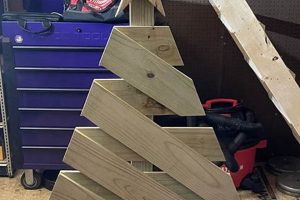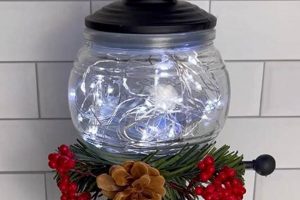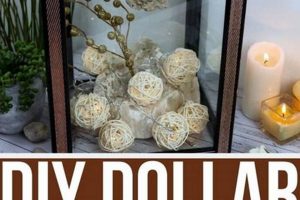Creating sophisticated and stylish interior design elements using materials sourced from discount retailers has become a popular trend. These projects, often involving inexpensive items, transform basic goods into elegant and personalized decorations for the home. An example would be utilizing glass vases and decorative stones from a budget store to create a visually appealing centerpiece resembling a higher-priced store-bought item.
The appeal of this practice lies in its affordability and the opportunity for creative expression. It allows individuals to enhance their living spaces without incurring significant expenses, democratizing access to aesthetically pleasing home environments. Historically, resourcefulness in home decorating has been a recurring theme, particularly during periods of economic constraint, with people finding innovative ways to improve their surroundings using available materials.
The following sections will explore specific techniques and project ideas that exemplify this approach to affordable and stylish home decoration. Considerations for material selection, design principles, and project execution will be addressed to guide individuals in creating successful and visually impressive outcomes.
Strategies for Elevated Dollar Store Home Decoration
The following tips provide guidance on achieving a refined aesthetic through the strategic use of budget-friendly materials. Attention to detail and design principles are crucial for successful execution.
Tip 1: Prioritize Material Selection: Opt for items with clean lines and neutral colors. Avoid overtly cheap-looking plastic or excessively bright, garish items. Focus on glass, ceramics, and natural fiber elements when available.
Tip 2: Enhance with Paint: A fresh coat of paint can dramatically transform inexpensive items. Consider using spray paint in metallic finishes (gold, silver, copper) or matte neutral tones for a sophisticated appearance.
Tip 3: Emphasize Texture: Incorporate textured elements such as rope, burlap, or textured paint to add visual interest and depth to projects. This elevates the perceived value of the items.
Tip 4: Employ Strategic Grouping: Display items in carefully curated groups rather than scattered individually. Groupings of odd numbers (three, five, seven) often create a more visually appealing arrangement.
Tip 5: Refine with Hardware: Replace inexpensive or unattractive hardware (knobs, handles) on drawers or containers with higher-quality alternatives. This simple swap can significantly enhance the overall look.
Tip 6: Consider Scale and Proportion: Pay attention to the size and scale of decorative elements in relation to the surrounding space. Items that are disproportionately small or large can detract from the overall aesthetic.
Tip 7: Incorporate Greenery: Artificial plants, thoughtfully selected and arranged, can add a touch of sophistication to a space. Opt for realistic-looking foliage and avoid overly artificial, brightly colored options.
Applying these strategies enables the transformation of inexpensive materials into visually appealing and sophisticated home dcor elements, thereby maximizing value and minimizing expenditure.
The subsequent section will explore specific project ideas, demonstrating the practical application of these principles.
1. Material Quality
Material quality is a critical determinant in the success of achieving a high-end aesthetic utilizing discount store supplies. The inherent properties of the base materials directly influence the final product’s visual appeal and perceived value. Inferior materials, such as flimsy plastics or poorly constructed frames, can undermine even the most skillful design efforts, resulting in an item that betrays its inexpensive origins. Conversely, selecting materials with inherent potential such as glass, ceramic, or natural fibers provides a more promising foundation for transformation. For example, a plain glass vase from a discount retailer, due to its inherent clarity and form, presents a better starting point for decorative enhancements than a similar vase made of thin, cloudy plastic. Therefore, careful evaluation and selection of materials are paramount.
The impact of material quality extends beyond aesthetics to encompass durability and longevity. While a project may initially appear successful, substandard materials are more prone to damage, wear, and fading, ultimately diminishing the item’s lifespan and perceived value. Investing slightly more time and effort in sourcing higher-quality materials within the available budget, such as selecting thicker gauge wire for a decorative sculpture or opting for fabric with a tighter weave for a repurposed cushion cover, can significantly improve the finished product’s resilience. Further, the application of protective finishes, such as sealants or UV-resistant coatings, can mitigate the effects of environmental factors on less durable materials.
In summary, material quality functions as a foundational element in transforming inexpensive items into sophisticated home decor. Careful selection, focusing on inherent properties and potential for enhancement, is essential. While budget constraints necessitate resourcefulness, compromising entirely on material quality can ultimately undermine the project’s success. The strategic balance between cost-effectiveness and material integrity enables the creation of visually appealing and durable home decor, defying the expectation of its humble beginnings.
2. Design Aesthetics
Design aesthetics, in the context of affordable home decoration, serves as a pivotal factor in elevating inexpensive materials to appear sophisticated. The selection and application of specific design principles directly influences the perceived value of a project. A well-considered color palette, for instance, can transform basic items into cohesive decorative elements. Utilizing neutral tones and metallic accents, often seen in high-end interiors, can imbue dollar store finds with a sense of understated elegance. Similarly, the arrangement of objects according to principles of symmetry or the rule of thirds can create visually appealing compositions, mitigating the inherent lack of intrinsic value in the materials themselves. For example, a collection of identically shaped glass vases from a discount retailer, unified by a consistent color scheme and arranged as a symmetrical centerpiece, can emulate the aesthetic of a professionally designed display.
The application of design aesthetics also extends to the modification of the materials themselves. Techniques such as painting, distressing, or adding decorative embellishments can alter the appearance of inexpensive items, rendering them unrecognizable from their original form. A plain wooden frame from a dollar store, when treated with a textured paint and antiqued with dark wax, can acquire the patina and character of a vintage piece. The selection of complementary textures and patterns is equally important. Pairing smooth glass with rough burlap or juxtaposing geometric patterns with organic forms introduces visual interest and complexity, diverting attention from the materials’ humble origins. Furthermore, understanding design styles, such as minimalist, bohemian, or Scandinavian, enables the creation of cohesive decorative schemes that reflect a deliberate and sophisticated aesthetic sensibility.
Ultimately, the successful integration of design aesthetics is what distinguishes generic discount store crafts from genuinely elevated home decor. It demands a discerning eye, a knowledge of design principles, and the ability to transform inexpensive materials into visually compelling objects. The challenge lies in overcoming the inherent limitations of the source materials through thoughtful planning and skillful execution. When design aesthetics are applied effectively, the resulting decor not only enhances the living space but also serves as a testament to the power of creativity and resourcefulness in achieving sophisticated style on a budget.
3. Execution Precision
Execution precision serves as a critical determinant in achieving a high-end aesthetic through budget-conscious home decoration projects. The transformation of inexpensive materials into sophisticated dcor hinges not only on the selection of suitable materials and the application of sound design principles, but also on the meticulousness with which the project is executed. Flaws in execution, such as uneven paint application, misaligned elements, or visible imperfections in assembly, can undermine the perceived value of the finished product, regardless of the quality of the materials or the ingenuity of the design. For example, a carefully designed mirror frame created from dollar store materials can appear cheap if the individual components are not accurately aligned and securely fastened. The effect is to negate the initial design intent.
Achieving execution precision often necessitates the utilization of appropriate tools and techniques. Precise cutting, accurate measurements, and careful application of adhesives or finishes are essential for creating a polished and professional appearance. The use of jigs or templates can facilitate consistent and accurate replication of design elements, while proper surface preparation, such as sanding or priming, ensures optimal adhesion and longevity of finishes. Furthermore, a commitment to detail is paramount. This includes paying attention to seemingly minor aspects such as the removal of excess glue, the smoothing of rough edges, and the proper alignment of hardware. Practical application can be observed in transforming a basic dollar store candle holder by applying gold leaf with precision, eliminating any smudges or unevenness. The resultant effect drastically enhances the initial item. The value is in the details.
In summary, execution precision is an indispensable component in realizing the potential of high-end discount store decoration. While creativity and resourcefulness are essential, they must be coupled with a commitment to meticulous craftsmanship. The cumulative effect of numerous small imperfections can significantly detract from the overall aesthetic, diminishing the perceived value and sophistication of the project. Conversely, meticulous execution elevates the project, transforming basic materials into items that belie their inexpensive origins. This attention to detail is essential for the creation of home decor that appears both stylish and well-crafted, despite its humble beginnings.
4. Functional Adaptation
Functional adaptation, in the context of creating elevated home decor from discount retailer materials, signifies the process of modifying and repurposing inexpensive items to serve specific needs and enhance usability within a living space. It moves beyond mere aesthetic embellishment, focusing on practical application and improved functionality, thereby increasing the perceived value and utility of the creations.
- Enhanced Storage Solutions
Basic storage containers sourced from discount retailers can be modified to improve functionality and aesthetics. Adding dividers, labels, or decorative elements transforms them into organized and visually appealing storage solutions for closets, pantries, or offices. For example, plain plastic bins can be lined with fabric and fitted with custom-made dividers to store clothing or accessories in a more organized and accessible manner. The adaptation enhances usability and integrates seamlessly with existing dcor.
- Repurposed Organization Systems
Inexpensive organizational items, such as utensil holders or desk organizers, can be repurposed for alternative uses. A metal utensil holder, when painted and mounted on a wall, can serve as a stylish and functional organizer for craft supplies or bathroom accessories. The adaptation addresses a specific organizational need while adding a unique decorative element to the space. This enhances usability and contributes to a personalized home environment.
- Improved Lighting Fixtures
Basic lighting fixtures from discount retailers can be modified to enhance their functionality and aesthetic appeal. Adding a custom-made lampshade or replacing the existing hardware with higher-quality components can transform a simple lamp into a stylish and functional lighting solution. For example, an inexpensive table lamp can be fitted with a fabric shade and a decorative pull chain to create a more sophisticated and personalized lighting fixture. Functional adaptation increases the aesthetic value and usefulness of basic lights
- Multipurpose Furniture Enhancements
Inexpensive furniture items can be adapted to serve multiple purposes, thereby increasing their functionality and value. A basic side table can be fitted with casters to allow for easy mobility or equipped with storage compartments to provide additional storage space. For instance, a simple wooden crate can be transformed into a rolling side table with the addition of casters and a painted finish, serving as both a functional surface and a mobile storage unit. This adaptation increases the usability and adaptability of the furniture item.
These examples highlight the importance of functional adaptation in elevating inexpensive materials to create sophisticated and practical home decor. By focusing on usability and addressing specific needs within the living space, these modifications transform basic items into valuable and integrated components of a well-designed home environment.
5. Perceived Value
The concept of perceived value is central to the success of elevating discount retailer materials into high-end home decor. Perceived value, in this context, represents the subjective assessment of an item’s worth based on its visual appeal, functionality, and perceived quality, rather than its actual cost. Achieving a high level of perceived value is the primary goal of transforming inexpensive materials into objects that appear more luxurious and sophisticated. The cause and effect relationship is direct: skillful design and execution result in an item whose perceived worth significantly exceeds its actual cost, thereby achieving a desirable outcome. For example, a mirror frame created from inexpensive plastic components sourced from a discount retailer might, through careful design, paint application and the addition of embellishments, be perceived as a hand-crafted item of substantial value.
The importance of perceived value stems from its ability to transform a budget-conscious approach into an aesthetically pleasing and satisfying outcome. Practical significance lies in the understanding that visual cues, such as color palettes, textures, and overall design style, heavily influence perception. Techniques such as mimicking high-end design trends, creating bespoke features, and carefully assembling the item contribute significantly to this outcome. The selection and strategic application of materials are similarly vital. For instance, the incorporation of metallic accents or the use of natural-looking artificial greenery can dramatically enhance perceived value, diverting attention from the underlying inexpensive materials.
In conclusion, the pursuit of sophisticated home decor using budget-friendly resources hinges on the ability to manipulate perceived value. The challenge lies in creating a product that defies expectations based on its origin and materials. By focusing on design, execution precision, and material enhancement, individuals can effectively increase the perceived worth of their creations, achieving a high-end aesthetic without incurring significant expense. Successfully achieving this elevated perception results in a home environment that is both stylish and reflective of personal creativity and resourcefulness.
6. Sustainability Focus
A sustainability focus significantly enhances the value proposition of affordable home decor projects. Repurposing materials inherently reduces waste, decreasing demand for new resources and minimizing environmental impact. When budget-friendly projects incorporate recycled or repurposed elements, they contribute to a more sustainable lifestyle. For instance, transforming discarded glass jars into decorative storage containers or converting old fabric scraps into quilted wall art demonstrates a commitment to environmental responsibility. The effect is a home decorated with items possessing both aesthetic appeal and ecological merit.
The importance of a sustainability focus extends beyond the immediate reduction of waste. Sourcing materials locally, even if from a discount retailer, can minimize the carbon footprint associated with transportation. Furthermore, selecting non-toxic paints, adhesives, and finishes ensures a healthier indoor environment. The practical application of this understanding involves deliberately choosing eco-friendly options whenever possible. This includes opting for water-based paints over solvent-based alternatives or selecting natural fibers over synthetic materials. Another example involves utilizing discarded wooden pallets from local businesses as a starting point for creating rustic furniture, thereby diverting waste from landfills.
In conclusion, a sustainability focus strengthens the ethical and aesthetic appeal of affordable home decor. The challenge lies in creatively repurposing materials while maintaining a high standard of design and execution. By prioritizing eco-friendly practices and resourcefulness, individuals can create stylish and personalized living spaces that reflect a commitment to both environmental responsibility and budgetary constraints. This approach transforms a simple home decor project into a statement of sustainable living.
7. Creative Innovation
Creative innovation is a fundamental element in transforming inexpensive materials into sophisticated home decor. Its presence elevates the perceived value and aesthetic appeal of items sourced from discount retailers, enabling the creation of high-end looks on a budget.
- Material Repurposing
This aspect involves identifying unconventional uses for readily available materials. For example, plastic storage containers can be transformed into geometric wall art through strategic cutting, painting, and arrangement. The inherent functionality of the material is secondary; the focus is on its potential for aesthetic transformation. This skill recontextualizes ordinary items into art, exceeding their initial purpose and perceived value.
- Technique Adaptation
This entails modifying established craft techniques to suit unconventional materials. Traditional woodworking skills can be adapted to work with repurposed cardboard, creating intricate structures that mimic the appearance of more expensive materials. Traditional fabric dying can be used on paper to create high end wallpapers and effects. This adaptation requires a deep understanding of the technique and the properties of the materials, merging artistic processes with budget-friendly resources.
- Design Mimicry
This aspect focuses on emulating high-end design trends using affordable materials. A popular example would be creating a faux marble effect on a tabletop using paint and sealant, mimicking the look of natural stone without the associated cost. Intricate designs made by expensive laser engravers can be created by printing, then using a wood burning tool to carve away to create a high end and personalized wooden sign, plaque, or art piece. This technique demands keen observation and an understanding of design aesthetics, allowing one to translate luxurious looks into affordable alternatives.
- Surface Treatment
Creative innovation is also evident in the inventive manipulation of surface finishes. Applying unique paint techniques, such as faux distressing or metallic leafing, to inexpensive items can significantly elevate their perceived value. Using a textured paint, then overlaying a metallic spray paint on top is one example. The application of sealants and protective coatings also adds durability and enhances the overall aesthetic. The manipulation of the surfaces of materials adds perceived value.
These facets collectively demonstrate the vital role of creative innovation in the realm of affordable home decor. The ability to repurpose, adapt, mimic, and manipulate allows for the transformation of humble materials into stylish and personalized home accents. The skill to see unconventional potential helps transform basic discount items into high end alternatives.
Frequently Asked Questions About High End Dollar Tree DIY Home Decor
The following questions address common concerns and misconceptions regarding the creation of sophisticated home decor using materials sourced from discount retailers.
Question 1: Is it genuinely possible to create “high-end” decor using dollar store materials?
Achieving a high-end aesthetic requires careful material selection, meticulous execution, and a strong understanding of design principles. The potential exists, but success is contingent on skill and attention to detail, rather than simply purchasing inexpensive items.
Question 2: What are the most critical factors in making a discount store DIY project look expensive?
Key factors include high-quality paint finishes, precise assembly, and the strategic use of texture and color. Avoiding overtly cheap-looking materials and focusing on items with clean lines is also essential.
Question 3: Are certain types of dollar store items better suited for these types of projects?
Yes. Glassware, ceramics, and items made from natural fibers generally offer a better foundation for transformation than cheap plastics or overly embellished items. Items with simple, classic shapes are easier to elevate.
Question 4: How can one avoid making a project look obviously “DIY” or homemade?
The key is in the details. Pay close attention to finishing touches, such as sanding edges, removing excess glue, and ensuring that all components are properly aligned. Invest in quality adhesives and paints.
Question 5: Is this approach truly cost-effective, considering the time and effort involved?
While the initial cost of materials is low, the time investment can be significant. The cost-effectiveness depends on the individual’s skill level and the value placed on their time. For those who enjoy crafting, it can be a rewarding and economical approach.
Question 6: Are there any safety concerns associated with modifying dollar store items?
Yes. It is crucial to use appropriate safety precautions when cutting, painting, or assembling items. Ensure proper ventilation when using paints or adhesives, and wear protective gear as needed.
In summary, the creation of sophisticated decor from discount retailer materials is achievable but demands skill, attention to detail, and a commitment to quality execution.
The following section will offer concluding thoughts and guidance for future DIY endeavors.
Conclusion
The preceding analysis has explored the feasibility of achieving sophisticated home decor through the utilization of materials sourced from discount retailers. Success in this endeavor hinges on a multifaceted approach encompassing meticulous material selection, adherence to sound design principles, precise execution, functional adaptation, manipulation of perceived value, commitment to sustainability, and a foundation of creative innovation. These elements, when synergistically applied, enable the transformation of inexpensive items into aesthetically pleasing and functional components of a stylish home environment.
As demonstrated, high end dollar tree diy home decor requires a dedication to craftsmanship and an understanding of design fundamentals, not merely a reliance on inexpensive materials. Embracing this challenge with diligence and ingenuity can result in significant cost savings and a personalized home aesthetic, demonstrating that sophisticated style is achievable regardless of budget limitations. The future of this approach lies in continued innovation and refinement of techniques, offering an ever-expanding range of possibilities for affordable and stylish home decoration.







